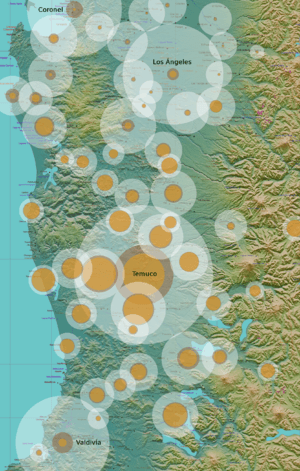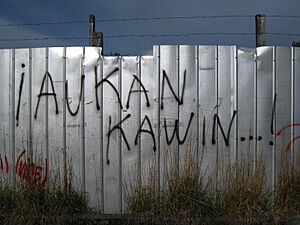Mapudungun facts for kids
Quick facts for kids Mapuche |
|
|---|---|
| Mapudungun | |
| Native to | Chile, Argentina |
| Ethnicity | Mapuche |
| Native speakers | 260,000 (2007) |
| Language family |
Araucanian
|

Region where most mapuche lived in 2002.
Orange: mapuche at the countryside; dark: mapuche in a city; white: non-mapuche. The circle of a place has an area as if 40 persons from there were living in a square of 1 km side. |
|
Mapudungun is a special language spoken by the Mapuche people. They live in parts of Chile and Argentina. It is a unique language, meaning it is not closely related to other languages.
What is Mapudungun?
Mapudungun is the language of the Mapuche people. It is spoken mainly in Chile and Argentina. This language is quite unique. It does not belong to a larger family of languages like Spanish or English do.
Who Speaks Mapudungun?
Even after the Spanish arrived, some groups in Argentina started speaking Mapudungun. For example, people from Patagonia and the Tehuelche group adopted it. This process is sometimes called "araucanization."
Today, about 260,000 people speak Mapudungun. Most of these speakers, around 250,000, live in the Central Valley of Chile. About 10,000 speakers live in the Patagonia region of Argentina.
Words from Mapudungun
Some words we use today come from Mapudungun. For instance, the name of the boldo tree comes from the Mapudungun word foldo.
The word "Poncho" is another example. It was adopted by Spanish and many other languages. It might have come from the Mapudungun word pontro. Another idea is that it came from the Quechua word punchu.
Images for kids
-
Chilean Proverb written in Mapuche and Chilean Spanish. The Mapudungun alphabet used here does not reflect an agreed-upon standard. In fact, there are three distinct alphabets currently used to write the Mapuche language.
See also
 In Spanish: Idioma mapuche para niños
In Spanish: Idioma mapuche para niños



